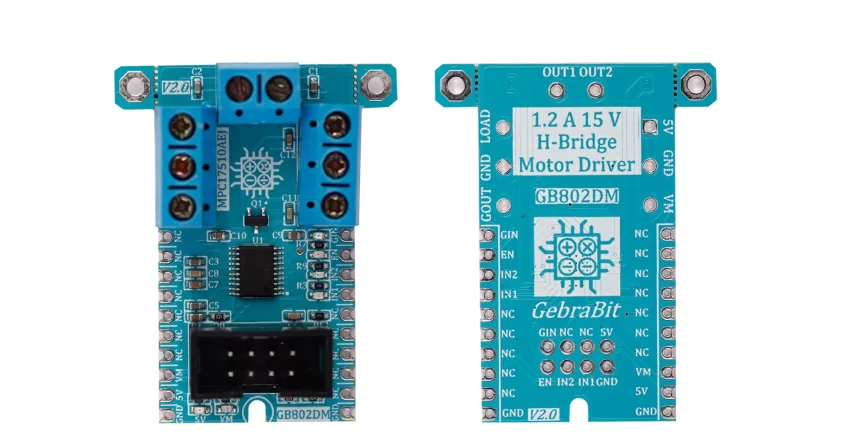In robotics, there are many types of motors such as DC motors, servo motors, stepper motors, etc. Choosing the right motor for a robotics project depends on the user’s intended application and there are different ways to use them.
Some motors can directly be controlled and run in a variety of ways, such as connecting a power supply directly to them. But if we want to control these motors using other control devices like wireless systems, microcontrollers, etc., we need something known as “MOTOR DRIVERS”.
Motor drivers act as interfaces between motors and control circuits. The motor requires high current while the controller circuit operates on low current signals. Therefore, the function of motor drivers is to take a low current control signal and convert it into a higher current signal that can drive the motor.

An overview of the MPC17510AEJ Motor driver

The MPC17510AEJ is a monolithic H-Bridge that can operate efficiently with supply voltages as low as 2.0 V to as high as 15 V. Its low RDS(on) H-Bridge output MOSFETs (0.45 Ω typical) can provide continuous motor drive currents of 1.2 A and handle peak currents up to 3.8 A.
This device contains an integrated charge pump and level shifter (for gate drive voltages), integrated shoot-through current protection (cross-conduction suppression logic and timing), and under voltage detection and shutdown circuitry.
This device is powered by SMARTMOS technology.
Specification
Applications
- DC Output Current: 1.2A
- VM: 2.0V to 15V
- Output Type: Analog-Voltage
- Interface: Digital – Logic, PWM
- Output Channels: 1 + 1Selonoid Driver
For more specifications, please refer to datasheet
- portable electronic applications
- digital and SLR cameras to control small DC motors.
GebraBit MPC17510AEJ module Key Features
- On Board, ON/OFF LED indicator for “5V” and “VM”
- On Board LED indicator for direction pins and GIN pin
- Control Pin access with IDC connector
- Screw terminal blocks for power, motor connections and selonoid
- GebraBit Pin Compatible with GEBRABUS
- It can be used as a daughter board of GebraBit MCU Modules
- Featuring Castellated pad (Assembled as SMD Part)
- Separatable screw parts to reduce the size of the board
- Package: GebraBit medium (36.29mm x 46.18mm)
- Schematic (.pdf)
GebraBit MPC17510AEJ module

Gebrabit MPC17510AEJ is a 2V to 15V, 2.1 A, 200 kHz, Low RDS(on), H-Bridge, brushed DC motor driver module which needs two separate power supplies for the internal circuitry and H-Bridge. Due to an integrated on Board logic N-channel mosfet GebraBit MPC17510AEJ module can drive Solenoids through the “LOAD”pin; Also users can drive external MOSFET through the “GOUT” pin.
Users can access the most important pins of the MPC17510AEJ through the GebraBit MPC17510AEJ module.
For easy accessibility, MPC17510AEJ gives access to the “5V”, “GND”, and “IN1”, “IN2”, “IN3”, “EN”, “GIN” pins by a 2×4 pin IDC connector to extend them on other boards.

To use this module it is enough to put the GebraBit MPC17510AEJ module in the BreadBoard, then by applying the proper voltage, set-up the GebraBit MPC17510AEJ module. Because of the compatibility of the GebraBit MPC17510AEJ module pins with the GebraBit STM32F303 pins, we recommend using the GebraBit STM32F303 microcontroller development module for testing and setting up this module.
To do so, you just need to put the GebraBit MPC17510AEJ module as Pin-to-Pin on the GebraBit STM32F303 module.

Introduction of module sections

MPC17510AEJ motor driver
It’s the main IC of the following module, which is in charge of controlling the motors and external MOSFET and is placed in the center of the module.

BSS138 MOSFET
Due to the integrated on Board logic N-channel “BSS138” mosfet GebraBit MPC17510AEJ module can drive Solenoids and external mosfet.

Motor terminal block
GebraBit MPC17510AEJ module has one screw terminal blocks for “OUT1” and “OUT2” to connect motors which is placed on top of the modules.

power supply terminal block
The terminal block which placed on the left side of this module is the power supply terminal and is considered to connect “VM”, “GND” and “5V” to the module.

MOSFET terminal block
As mentioned earlier, the GebraBit MPC17510AEJ module has the ability to drive solenoids so a terminal is installed on the right side of the module for “GOUT”, “GND” and “LOAD” for connecting selonoid to onboard mosfet.

Input pins LEDs
Each of the “IN1”, “IN2” and “EN” pins of the module, which are intended to control the movement direction of the motors, and the “GIN” pin which is intended to control the input of the N-Channel MOSFET, have a dedicated LED. These LEDs will be lit by applying voltage to each of these pins.

signal port
For easier access to the “5V”, “IN1”, “IN2″,” EN”, “GIN” and “GND” pins, an ” IDC-2×4″ connector is installed on the GebraBit MPC17510AEJ module, which helps the users to connected to the mentioned pins easier just by connecting an appropriate IDC cable to this connector.
You can see how the pins are arranged in the below picture.

Power LEDs
5V LED: By applying “5V” voltage to the module via the corresponding pins, “5V” LED will be lit.

VM LED: By applying voltage to the “VM” pin, “VM” LED will be lit.

GebraBit MPC17510AEJ Module pins

Supply pins
- VM: The “VM” pin gives power to the internal H-Bridge of the IC to drive the motors with voltages between “2V” to “15V” with a peak current up to “2A”.
- 5V: The internal circuitry operates with a 5V through the “5V” pin.
- GND: This is the ground pin of this module.

Control pins
IN1 and IN2 : these pins are motor direction control pins.
By applying voltage to the “IN1” Pin, motor is ON and turning forwards and by applying voltage to the “IN2” Pin, motor is ON and turning backwards and If voltage is applied simultaneously to both “IN1” and “IN2” pins, the motor will stop.

- EN: The speed of motor can be controlled through this pin. To do this, it’s enough to apply the PWM signal to this pin.
- GIN: this pin is used to control the input of the N-Channel MOSFET.

Connect to the processor

connect to GebraBit STM32F303
To connect the GebraBit MPC17510AEJ module to the GebraBit STM32F303 microcontroller module, due to the compatibility of the pins of this module with the GebraBit STM32F303 pins, it is enough to place it on the microcontroller as Pin to Pin then you can start the motor just by applying “5V” voltage to the “5V” pins of GebraBit MPC17510AEJ and GebraBit STM32F303 modules and a proper voltage to the “VM” pin.
Considering that the “VM” pin gives power to the internal H-Bridge of the IC to drive the motors with voltages between 2 to 15V , the appropriate voltage to apply to this pin is a voltage between 2 to 15 volts.
Here for better understanding the separate connection of these two modules is shown.

connect to GebraBit ATMEGA32A
To connect the GebraBit MPC17510AEJ module to the GebraBit ATMEGA32A microcontroller module, first connect a “5V” power supply to the “5V” pin of the microcontroller and connect the power pins of the two modules to each other, then apply an appropriate voltage to the “VM” pin. Now it is enough to connect each of the “IN1”, “IN2” and “GIN” pins to one of the GebraBit ATMEGA32A pins and then connect the “EN” pin to one of the GebraBit ATMEGA32A “PWM” pins (pin OC1).

Attention: We applied 9V voltage to the modules assuming that the “9V” voltage does not harm the motors.
connect to ARDUINO UNO
follow the below steps to connect the GebraBit MPC17510AEJ module to the ARDUINO UNO:
- Connect the “5V” pin of MPC17510AEJ module to the “5V” output pin of the ARDUINO UNO board. (red wire)
- Connect the “GND” pin of the MPC17510AEJ module to the “GND” pin of the ARDUINO UNO board (black wire).
- Connect the “VM” pin of the MPC17510AEJ module to the “VIN” pin of the ARDUINO UNO board.(orange wire)
- Connect the “EN” pin of the MPC17510AEJ module to one of the “PWM” pins of the Arduino UNO board and Connect each of “IN1” , “IN2”, and “GIN” pins to other Arduino pins.
You can see how to connect the two modules according to the above mentioned Descriptions, in the below picture:
Note: when you use the Arduino board to start the MPC17510AEJ module, if your Arduino board is connected to the computer (PC) and gets its power from the USB port of the PC, you should note that the PC USB port does not flow more than 500mA. So we recommend you use a better voltage source for Arduino.
You can see how to connect the two modules according to the above mentioned Descriptions, in the below picture:

Note: When applying voltage to the “VM” pin, pay attention that the applied voltage is not higher than the maximum working voltage of the motors you have, otherwise the motors will be damaged.

